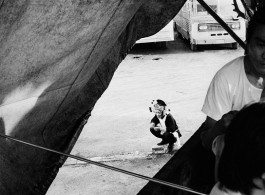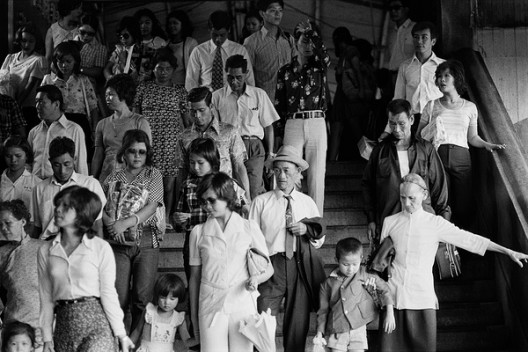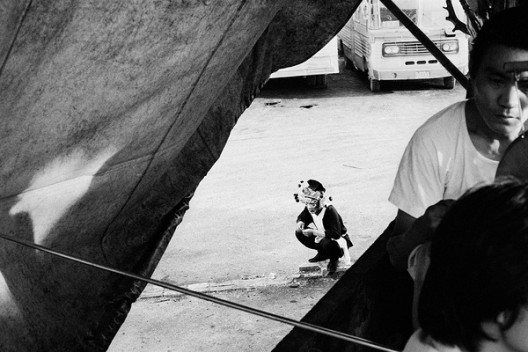September 5—October 4, 2015
Shanghai—Minsheng Art Museum is pleased to present Won’t Somebody Bring the Light, photography exhibition of Cheng Tsun-Shing on September 7th. The exhibition will feature 149 photos, in color or in black and white, the artist shot from 1973 to 1978 while he traveled around Taiwan. About half of the works are put on display for the first time.
The title “Won’t Somebody Bring the Light” derives from “Smaller Rules of Demeanor” (shao yi) of Book of Rites (li ji), originally meaning that “If one came late and yet arrived before the torches were lighted, it was announced to him that the guests were all there”. A young man holding a candle stood in the darkness, waiting for the guests to the banquet. He would need to guide the latecomers to the right position but have to remain silent. The host of the banquet would introduce the latecomer to those who were already seated. The young man listened, quietly, and then went back to wait for other guests. Such is the “rules of demeanor” for the young man. It’s a learning and practicing process of rites and ethics. “The young man is not yet the host but a witness of the ethical relations.”
The exhibition consists of 15 groups of photo works, namely “Luzhou County”, “The Lin Garden: Ruin Scenes”, “Mourning”, “Bangka Area”, “Huanlien Ferry”, “Lanyu Island: Commuter Ferry”, “Lanyu Island”, “Tamsui Township”, “Taipei Main Station”, “Zidi Opera”, “Chinese Opera Troupe”, “Kun Dan”, “Vagabond Performers in the Afternoon”, “Multiple Exposure” and “Color”. As if taking us back to forty years ago, these photos cast light on the point of departure of the rite of a young man’s spiritual journey.
“Luzhou County”(1973-1974) plays the role as a prelude. Back then Cheng Tsun-Shing probed into the changes in the life in this little county through his camera. While making a record of scenes of everyday life, the artist also tried something experimental. Realistic photos in combination with montage collage imbued scenes of daily life with a sense of surrealism. “Luzhou County” was also presented in the first solo exhibition of Cheng Tsun-Shing and due to the passing of time and other reasons, most of the works and negative films were eroded and damaged. Works to be put on display this time are among the few that remain intact.
In “Bangka Area” (1976-1978), it seems more appropriate to say the artist put more emphasis on the darkness that overwhelmed the photographer as well as the overall background – a gazing position that was constantly in the move and could hardly be fixed – than on the dim and somewhat lonely lights shone in the night markets and old restaurants on Huaxi Street.
“Zidi Opera”, “Kun Dan”, “Chinese Opera Troupe”, and “Vagabond Performers in the Afternoon” (1975-1978) cast light on the life of grass-root opera troupes and vagabond performers. In these works viewers would not see too many dramatically cozy scenes and faces radiating glory of humanity. Instead, what featured in these series was an integration of front stage and back stage, real life and performed life, wildness and grass-root stages. A sense of humanistic care and concern for the troupes and the vagabond performers could be perceived from within.
This is the second solo exhibition of Cheng Tsun-Shing after his first one “Scenes of the Floating World of Luzhou County” in 1975, and the negative films were sealed in black boxes after the pictures were shot. In this regard, the exhibition, by transforming the gallery space into a special “time/space installation”, presents an angle of multiple “viewing” that goes beyond the boundaries of time and space. In other words, the general meaning of “photography show” is diluted, or even canceled in a way. From these photo works, viewers are able to probe into the artist’s aesthetic thinking of drama, film and painting some forty years ago; and as a matter of fact, the artist himself is that “young man with a candle” who “stood in the darkness, waiting for the guests to the banquet”. Silent as he is, he reflects upon himself within such silence. It’s a rite for the growth of the young man and mirrors a kind of implicit ethical and philosophical attitudes.
Writing in an Island, a poetic documentary directed and produced by Cheng Tsun-Shing, will be screened on a regular basis during the exhibition. Won’t Somebody Bring the Light will run through October 4th.
Cheng Tsun-Shing
Cheng Tsun-Shing received a PhD in Linguistics, from the École des Hautes Études en Sciences Sociales, France. He is the founder of the Editions du Flaneur, hosting the translation project of Vocabulaire de la Psychanalyse. His documentary works include Immigrants (1979), A Kun (1980), Zheng Zhai-dong (1992-1993), Narrative Biography of Yao Yi-wei (1992-1997), The Coming of Tulku (2011) and Port of Mists (2011). He is often the guest speaker at international seminars that publish film theses; his unique insight and interpretation are well acclaimed.





